As 2012 gets ready to turn the page to 2013, I thought I would close out the year with one more post - as infrequent as they have been in recent months - to wrap up some of what has been going on since we
moved to Arizona in May.
One of the reasons that posts to this page have been less frequent than in the past is that I have been posting so much on three other web sources: the
Arizona State University Trombone Studio website, the
ASU Trombone Studio Facebook page and the
ASU Trombone Studio YouTube channel. These three pages have a great deal of information about what I've been doing since starting up my position as
Professor of Trombone at ASU. While I do not use Facebook personally, I have found it to be a very good tool
for getting out information about our work in the Trombone Studio at ASU, both to current and prospective students, as well as to those who are interested in what we are doing.
With the first semester now in the books, I can already look back on what has been a very rewarding new chapter of life. The students at ASU are working hard and their work is paying off - people are noticing that things are different
when it comes to trombone playing at ASU and our students get the credit for that. Our ASU Desert Bones Trombone Choir has also become a big part of what we're doing, and it has provided us with a great crucible for working on a host
of important aspects of playing. January and February will feature concerts with our trombone players (see the "Calendar" section of our ASU Trombone Studio website for more information).
On a personal level, it is great to be experiencing winter in a whole new way. After a lifetime of living in the northeast, the word "snow" is no longer in my vocabulary. After we purchased our house here in Arizona two years ago, I put up a
page on my website that showed the ying and yang of our live in Boston and what would eventually become our new life in Arizoina. It shows photos of our house in the Boston area during the Christmas snowstorm of 2009, and our home
in Arizona in November 2010. Click
HERE
to see the different perspectives.
This week I experienced something else that is new: I've officially become a free lance musician. My phone rang on Sunday morning as we were getting ready to go to church. The personnel manager of the Phoenix Symphony was on the line,
saying that one of their trombone players had taken ill and he wanted to know if I would be able to play two performances of Tchaikowsky's, The Nutcracker on Sunday and one on Monday - these performances were with Ballet Arizona.
Grateful that I had been keeping in shape on the trombone, I was happy to say yes and help out, so for the first time since 1990 when I recorded the piece with the Boston Symphony, I played performances of the complete Nutcracker.
Fun, for sure.
And, yesterday, I posted a poem on the ASU Trombone Studio Facebook Page that I jotted down the other day; I'd like to share on this page, and at the same time wish all of you reading this a very Merry Christmas and all the best for the
coming year, 2013.
A Visit From Santa Claus To A College Trombone Player
T'was the night before Christmas and all through my home,
All the horns were in cases, including trombones.
For after the finals and juries and tests,
It was time for some shut-eye; I needed some rest.
I was dreaming of straight mutes and pBones and more,
When I woke to a sound that I'd not heard before.
And what should I see on my roof up on high?
A Moravian choir, with trombones playing fine.
Alessi and Lindberg, Kleinhammer and Yeo,
Were all playing their horns, their heads covered with snow.
And who should be leading this heavenly band?
But old Santa himself, a trombone in his hand!
"On JJ! On Jorgen! On Tommy and George!"
This band was so sweet, I sure did thank the Lord!
"On Norman and Pryor, Steve, Urbie and Frank!"
Some others played, too, but my mind drew a blank.
I grabbed my trombone and I lubed up the slide,
With no time for a warm-up, I hurried outside.
The gang was all playing some mighty nice tunes,
And we jammed some cool charts by light of the moon.
I invited them in just to warm up their chops,
But they just kept on playing, man, this sure was tops!
Saint Nick put his horn down to fill up my stocking,
With valve oil, and slide cream, CDs - so inspiring!
In time, things wound down and they packed up their horns,
And the sleigh got revved up and was heavenly borne.
But Santa looked back, and he said with a smile,
"Merry Christmas to all, and don't forget to keep practicing even though you're on vacation!"
--- © Douglas Yeo, Christmas 2012 (with apologies to Clement Clarke Moore)
--- First posted December 24, 2012, on the ASU Trombone Studio Facebook Page
--- Santa Claus image © Hornpipe, courtesy Dreamstime
October 16, 2012 - COMMENTARY
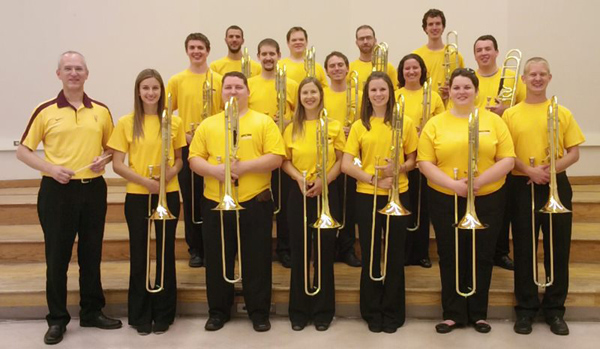 Readers of this page will note it has been several months since I have added a new entry. But this does not mean I have been sitting in my favorite chair with my feet up. On the contray, life is busy and satisfying, and there is much
to report.
Readers of this page will note it has been several months since I have added a new entry. But this does not mean I have been sitting in my favorite chair with my feet up. On the contray, life is busy and satisfying, and there is much
to report.
First, shortly after my entry of August 12 (below), I began my new season of life as Professor of Trombone at Arizona State University. This has been a tremendously satisfying collaboration, with the pleasure of interacting daily with
my talented and hard-working students at ASU. The photo at left was taking on the first day of classes in August, at the end of our first Arizona State University Desert Bones Trombone Choir rehearsal. Earlier that day, we had
recorded an arrangement of the National Anthem, a fitting start to our time together.
Now, having reached the mid-point of the semester, we are well underway, with weekly trombone lessons, weekly trombone studio class, weekly trombone choir rehearsal and I also teach a weekly class for trombone majors on the subject of
trombone pedagogy and materials (I will teach a trombone literature class in the spring semester). Applications are already coming in from people interested in studying at ASU beginning in Fall 2013, and several students have
upcoming recitals. It is an exciting time for all of us involved with the trombone at ASU.
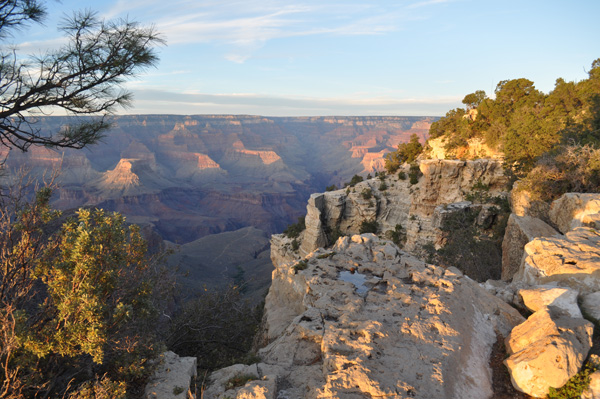 One of the reasons that I have not been updating this page is that all of my ASU related announcements are being made to several other websites. I invite you to visit our
ASU Trombone Studio website, our
ASU Trombone Studio Facebook Page
(if you're interested in getting regular updates of our activities, simple "like" our page) and our
ASU Trombone Studio YouTube channel
that will be growing son with videos from recitals and concerts. As you can see from these
websites and pages, we have been very busy with the trombone in our hands at ASU, and we welcome you to join us in sharing what we're doing.
One of the reasons that I have not been updating this page is that all of my ASU related announcements are being made to several other websites. I invite you to visit our
ASU Trombone Studio website, our
ASU Trombone Studio Facebook Page
(if you're interested in getting regular updates of our activities, simple "like" our page) and our
ASU Trombone Studio YouTube channel
that will be growing son with videos from recitals and concerts. As you can see from these
websites and pages, we have been very busy with the trombone in our hands at ASU, and we welcome you to join us in sharing what we're doing.
One of the main reasons my wife and I decided to relocate to the southwest of the United States is because of our great love of hiking in the National Parks of the west. We have enjoyed visiting these parks since 1978 and this past weekend,
during ASU's fall break, we decided to visit Grand Canyon National Park in northern Arizona. We have been to the Grand Canyon several times - we have lost track - five? - six times? - but we never tire of its beauty and grandeur.
Hiking down into the canyon as well as the length of the rim trail reveals surprises at every turn. The photo at right shows the play of the sun one evening near sunset. The small puddle is all that is left from the previous night's
dusting of snow on the South Rim. A photograph cannot even begin to show what this scene looked
like in the moment it occurred, but I take hundreds of photographs because I cannot help but try to document this most remarkable of natural settings. Seeing
as Arizona's nickname is The Grand Canyon State, we thought it fitting that our first vacation since becoming Arizona residents should be to its most iconic destination.
In our four days at Grand Canyon we enjoyed all the Park has to offer, and we returned home today refreshed. If you have never had the opportunity to visit the Grand Canyon, I'd like to encourage you to find a time to do so. It is
unforgettable - whether your first or fifth (or sixth...) time.
More anon.
August 12, 2012 - COMMENTARY
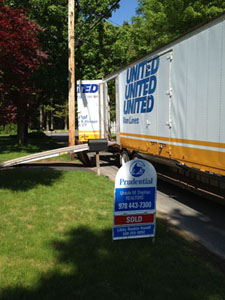
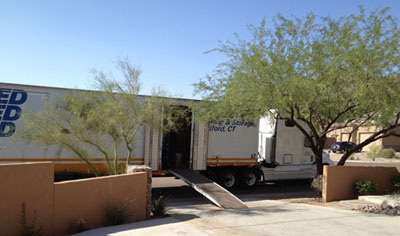 Since my last entry on May 11 over three months have passed, but it feels more like three years when I consider all that has happened in that time. My wife and I sold our
houses in Massachusetts, we moved to Arizona, I moved back to Massachusetts to play my final weeks with the Boston Symphony and we have moved back to Arizona to begin our
new life in the Valley of the Sun. Huge, life-changing events, for sure, but amidst this whirlwind of activity has been a great sense of peace as we move from from one
chapter of life to another.
Since my last entry on May 11 over three months have passed, but it feels more like three years when I consider all that has happened in that time. My wife and I sold our
houses in Massachusetts, we moved to Arizona, I moved back to Massachusetts to play my final weeks with the Boston Symphony and we have moved back to Arizona to begin our
new life in the Valley of the Sun. Huge, life-changing events, for sure, but amidst this whirlwind of activity has been a great sense of peace as we move from from one
chapter of life to another.
From east (photo, left) to west (photo, right), our move went smoothly. I don't think we could have asked for a better convergence of events that led to our move working well. Of
course it is a major event, and upon arriving in Arizona, we had hundreds of boxes that needt to be unpacked, their contents put in new places, and then the boxes recycled. Just think about the task of flatening and transporting that many boxes to
a recycling center - it was certainly more than I could put out for weekly curbside collection.
But this all came together nicely, and now we are in Arizona, settled and ready for the next stage of life. Since the move in May, life has been a whirlwind of activity and it's time to give an update that is long overdue.
Following our move and unpacking, I returned to Tanglewood, the Boston Symphony Orchestra's summer festival home, for my final five weeks of concerts with the BSO. Those weeks were full of
spectacular symphonic repertoire, and it seemed the programs had been designed as a "final lap" around the BSO universe for me. We played symphonies 4, 5, and 6 of Tchaikovsky (our section refers to
the Tchaikovsky 6 as our "fight song" becasue we play it so often), a concert of music by Wagner (that includes the most exposed entrance for trombones in the entire repertoire, the "Love Death"
from Wagner's "Tristan and Isolde" - what a joy it was to negotiate it successfully once again with my colleagues Toby Oft and Steve Lange) and much more. While I have not spent this last year
considering that every time I played a piece might well be the "last" time I played it, I could not help thinking about the great privilege I've had to play with the Boston Symphony these past
27 years, and the incalcuable amount of repertoire that has passed across my music stand during that time.
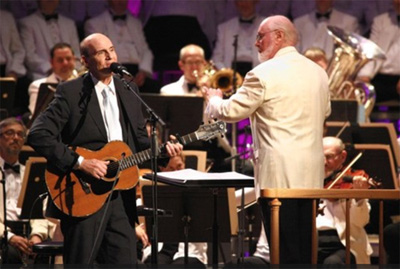 I joined the BSO in 1985, during the Boston Pops' 100th Anniversary season. And, as it turned out, I have retired from the BSO during the Tanglewood 75th anniversary season. These were nice
bookends to my BSO career, and at the Tanglewood Anniversary concert, we found ourselves being recorded for broadcast on the PBS program "Great Performances." This photo (at left, by Hilary Scott) shows
a snapshot of a moment in the program, with James Taylor singing with John Williams conducting the Boston Pops - you can see me in the middle of the photo, sitting in the back row adding my
contribution to the proceedings.
I joined the BSO in 1985, during the Boston Pops' 100th Anniversary season. And, as it turned out, I have retired from the BSO during the Tanglewood 75th anniversary season. These were nice
bookends to my BSO career, and at the Tanglewood Anniversary concert, we found ourselves being recorded for broadcast on the PBS program "Great Performances." This photo (at left, by Hilary Scott) shows
a snapshot of a moment in the program, with James Taylor singing with John Williams conducting the Boston Pops - you can see me in the middle of the photo, sitting in the back row adding my
contribution to the proceedings.
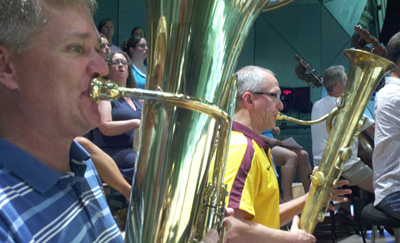 I also had the opportunity to play ophicleide once more in the BSO, in a performance of Berlioz's Damnation of Faust conducted by Charles Dutoit. In this photo (taken by Randy Hawes,
who was playing third trombone as I slid down the section to play ophicleide), you can see BSO tubist Mike Roylance and me playing the "Amen" fugue from Faust. Over the years, I have played
many instruments with the BSO - these include not only bass trombone, but contrabass trombone, tenor trombone, bass trumpet, euphonium, serpent and ophicleide. Bringing serpent and ophicleide
to the BSO is a special thing for me, as it provides an opportunity to bring back "old sounds" that have not been heard in many years in particular repertoire. It was especially fitting to
play this great work by Berlioz, who, after J. S. Bach, I enthusiastically can call my "favorite composer."
I also had the opportunity to play ophicleide once more in the BSO, in a performance of Berlioz's Damnation of Faust conducted by Charles Dutoit. In this photo (taken by Randy Hawes,
who was playing third trombone as I slid down the section to play ophicleide), you can see BSO tubist Mike Roylance and me playing the "Amen" fugue from Faust. Over the years, I have played
many instruments with the BSO - these include not only bass trombone, but contrabass trombone, tenor trombone, bass trumpet, euphonium, serpent and ophicleide. Bringing serpent and ophicleide
to the BSO is a special thing for me, as it provides an opportunity to bring back "old sounds" that have not been heard in many years in particular repertoire. It was especially fitting to
play this great work by Berlioz, who, after J. S. Bach, I enthusiastically can call my "favorite composer."
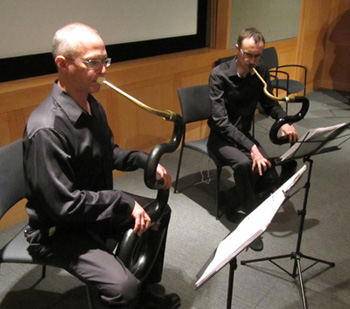 My time back at Tanglewood was not limited to BSO concerts. In mid-July, I drove to New York City to play a recital of duets for serpent with the fine French serpent player, Volny Hostiou, as part
of the Second Historic Brass Seminar, hosted by the Historic Brass Society and held at the Metropolitan Museum of Art. Volny and I had played together several years ago in Michaelstein, Germany,
and we encored part of our recital we gave at that time at this program in New York. The recital was a great success, and it is always nice to see friends from around the world at these
kinds of scholarly conferences, where one can hear recitals, see papers presented, and engage in lively and fruitful conversation about brass research.
My time back at Tanglewood was not limited to BSO concerts. In mid-July, I drove to New York City to play a recital of duets for serpent with the fine French serpent player, Volny Hostiou, as part
of the Second Historic Brass Seminar, hosted by the Historic Brass Society and held at the Metropolitan Museum of Art. Volny and I had played together several years ago in Michaelstein, Germany,
and we encored part of our recital we gave at that time at this program in New York. The recital was a great success, and it is always nice to see friends from around the world at these
kinds of scholarly conferences, where one can hear recitals, see papers presented, and engage in lively and fruitful conversation about brass research.
Of course, the great highlight of my final weeks with the BSO was my final weekend of concerts. It was a joy to have our daughters and their men come back to Tanglewood from Chicago and San
Francisco so they could share in all of this us. In addition to three BSO concerts in that weekend, the BSO brass section gave a recital in Seiji Ozawa Hall at Tanglewood. Each section of the BSO brasses played a piece (the low
brass choice was Joseph Kreines' Chorale Variations: Jesu meine Freude), and then we came together for a performance of Henri Tomasi's Fanfares liturgiques, one of the greatest
pieces ever written for brass ensemble.
We spent time visiting special places our family had enjoyed over the years, and when Sunday, August 5 came around, it was time for my final concert with the BSO.
The day started, fittingly, with our going to Hope Church in Lenox, Massachusetts, the church where our family has worshipped in the summers since 1985. My wife, Pat, and I played a solo
during worship, 'Tis So Sweet to Trust in Jesus, the piece we always seem to play when we finish a concert at a church or say goodbye to a congregation (It is the final track on my
solo CD, Cornerstone).
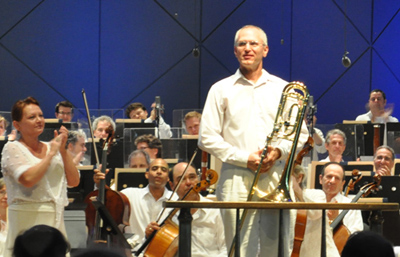
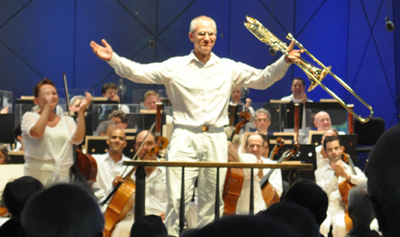 The BSO concert that afternoon was conducted by Loren Maazel and concluded with Berlioz's Symphonie fantastique. After the final C major chord, I was called up to the podium to take
my final bow as a member of the BSO. I was heartened by the wonderful support and response of the audience and my colleagues as I acknowledged their applause, and as I looked out, I smiled broadly,
remembering in an instant a career of concerts in that very special place.
The BSO concert that afternoon was conducted by Loren Maazel and concluded with Berlioz's Symphonie fantastique. After the final C major chord, I was called up to the podium to take
my final bow as a member of the BSO. I was heartened by the wonderful support and response of the audience and my colleagues as I acknowledged their applause, and as I looked out, I smiled broadly,
remembering in an instant a career of concerts in that very special place.
Following the concert was the annual party for BSO retirees. This is always a nice event, where not only the current members of the BSO attend, but former members come as well. It was great
to see my former trombone colleagues Ron Barron and Norman Bolter, as well as Bill Moyer, who played second trombone in the BSO from 1952-1966 and who was personnel manager of the orchestra when
I joined. Both my viola colleague, Mark Jeanneret, and I were honored as this year's retirees, and we were both roasted and toasted by our colleagues.
My former percussion colleague, Frank Epstein, Ron, Norman, Toby and Steve all spoke on my behalf. Gifts serious and silly came my way, and there is much for me to hold in my heart that my
colleagues said to me. The BSO presented me with a certificate of service, a copy of the program from my first opening
night concert with the BSO in Symphony Hall (along with the page listing all personnel from that time) and a large photo of the BSO around which was a wide matte that contained signatures of my
current colleagues. And, of course, my pension! The photo below, at right, shows me with my colleagues, Steve Lange, Norman Bolter and Ron Barron, after they presented me with a signed photo
of the brass section when I joined the BSO and my current section.
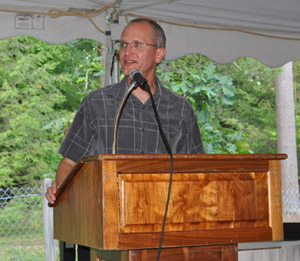
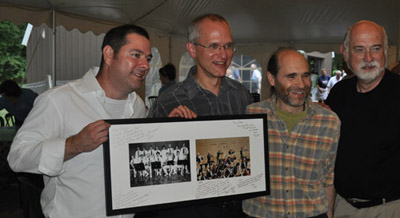 When it was time for me to speak, I was very happy to see Jim Markey, my successor in the BSO's bass trombone chair, in attendance, and it was my turn to give HIM a gift - a Boston Red Sox hat to
welcome him to Boston from New York. After I made my comments, it was time to hand the keys to my locker and trombone trunk to Jim and for our family to gather once more at Tanglewood. As I headed
out the gate to our car, I felt only joy with no regrets. This transition to our new time of life in Arizona - and my starting up my new position as Professor of Trombone at Arizona State
University - has been so clear and has worked so well, that I could only be grateful to God for all that has transpired.
When it was time for me to speak, I was very happy to see Jim Markey, my successor in the BSO's bass trombone chair, in attendance, and it was my turn to give HIM a gift - a Boston Red Sox hat to
welcome him to Boston from New York. After I made my comments, it was time to hand the keys to my locker and trombone trunk to Jim and for our family to gather once more at Tanglewood. As I headed
out the gate to our car, I felt only joy with no regrets. This transition to our new time of life in Arizona - and my starting up my new position as Professor of Trombone at Arizona State
University - has been so clear and has worked so well, that I could only be grateful to God for all that has transpired.
So, as I said when I closed my speech to my colleagues, now it is, "Westward Ho! Westward Yeo!" Thank you, Boston Symphony, for so many years of great experiences and concerts. Now it is time to
look ahead to a new chapter. My driver's license now has a photo of the Grand Canyon, and I no longer own a snow blower, lawn mower or rake. The contrasts between Boston and the Valley of the Sun
could not be greater. But in their own way, at their own time, each has been just the right place for us. And for that, we are very, very grateful.
May 11, 2012 - NEW
When I move to Arizona, I will be taking up the position of Professor of Trombone at Arizona State University. Last week, we launched a
website for the ASU trombone Studio
and a
Facebook Page for the ASU Trombone Studio.
I hope you'll visit them and see some of what will be happening in the Valley of the Sun for trombone players at Arizona State.
May 5, 2012 - COMMENTARY
Sometimes pictures tell more than words. And for once I am at a loss for words. On Saturday night I gave my final performance in Symphony Hall as a member of the Boston Symphony Orchestra. The program was memorable: Stravinsky's Symphony of Psalms, and
Beethoven's Ninth Symphony. At the end of the concert concertmaster Malcolm Lowe called me to the front of the stage for a bow. On the way to the podium, I shook hands and had a few words with Maestro Bernard Haitink, who was the conductor for
the evening's program. As I stood on the podium looking out at the audience assembled, with my colleagues in the Boston Symphony and the Tanglewood Festival Chorus behind me, a cascade of wonderful memories came over me. There are no words to explain how I felt.
My wife, Patricia, was in the audience, my wonderful wife of nearly 37 years who has stood by me since those early days when I was practicing for auditions. Her love and support for me is greater than I could ever express.
And to share this moment with Bernard Haitink - one of the great conductors of our time and a person with whom I have enjoyed a warm personal relationship for many years - made all of this particularly nice.
After I had bowed, it was the turn of my viola colleague, Mark Jeanneret, who also is retiring from the Boston Symphony this season. After he bowed to the audience to great acclaim, we climbed the podium together as members of the Boston Symphony with over
60 years of experience in the BSO between us.
This ritual will happen all over again this summer at the Boston Symphony's summer festival, Tanglewood, on August 5. That will be my last concert as a member of the Boston Symphony, and following the performance, I will attend the annual party for Boston Symphony retirees. There I will meet up
with former players who have retired before me, many of home were role models to me when I first join the orchestra. On that day I will join their ranks, as I head to a new season of life in Arizona.
Until then, there will be more concerts to play, more words to write, and more events to reflect upon. But these few words are completely inadequate to express what these photographs (all taken by Stu Rosner, courtesy Boston Symphony Orchestra) show. 27 years in
the Boston Symphony can't be summed up in words or even images. Instead, the concerts that I have played and the notes that have come out of the the bell of my trombone will have to speak for themselves. We now move ahead with plans to move to Arizona next week before coming back for
several weeks at Tanglewood in the summer. But that is a tale for another time.
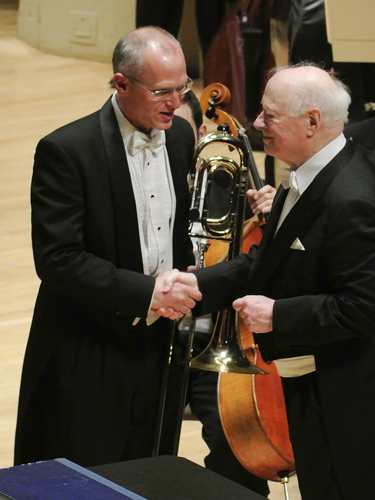
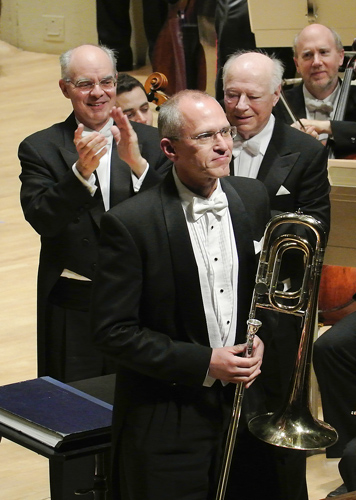
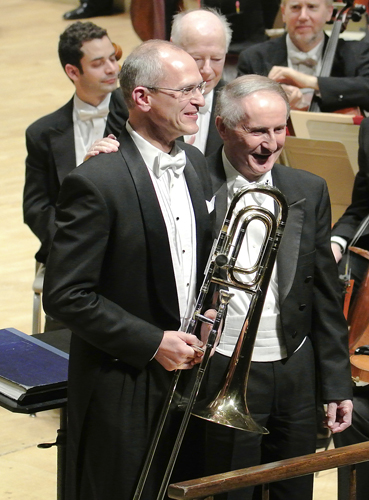
May 4, 2012 - COMMENTARY
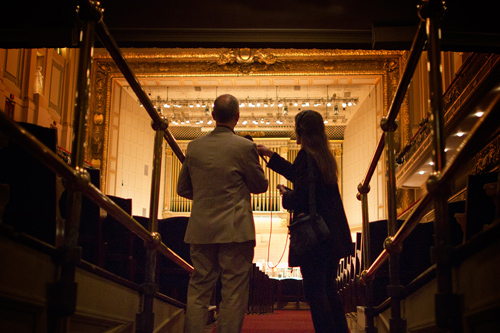 Over the years, I've given a number of interviews for both print and broadcast media. Today, I was featured on the National Public Radio program, Here and Now. The program is out of WBUR, Boston's leading NPR station (based at Boston University). The interview, along
with photos and commentary, can be found by clicking
HERE.
Over the years, I've given a number of interviews for both print and broadcast media. Today, I was featured on the National Public Radio program, Here and Now. The program is out of WBUR, Boston's leading NPR station (based at Boston University). The interview, along
with photos and commentary, can be found by clicking
HERE.
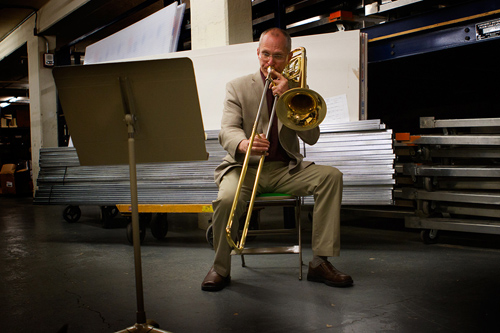 When Lynn Menegon of Here and Now emailed several months ago to ask if I would be interested in giving the program a tour of Symphony Hall, I was initially puzzled. A tour of Symphony Hall for Radio? While the Hall is Boston's "proud temple of music" and
sound is what it is about, the Hall has such an important visual element that I wondered what a discussion of the Hall on radio would be like. But when Lynn and audio engineer and photographer Jesse Costa (who took the photos, left, right, and below) arrived for the interview, I knew right away that
the interview would be both fun and unique. For about an hour, we walked around the hall, showing Lynn and Jesse the ins and outs of places where most people who attend Boston Symphony concerts never go. Such as the basement where our tour and instrument trunks are
kept, and where all of the operating systems - heat, steam, electrical - are located. On the interview, you can hear me warming up deep in the Hall's basement (photo above, right). As we walked through Symphony Hall - past the electrical, paint and carpentry shops, into the Archives, and finally into the great Hall itseslf - I was fascinated with how Lynn kept moving her microphone to pick up the sound of footsteps, trunks and doors opening, and the ambient sound that is ubiquitous in the lobbies and offices
when a concert is not going on. The interview took place on a day when the Hall was being prepared for violin auditions so at times our voices were hushed.
When Lynn Menegon of Here and Now emailed several months ago to ask if I would be interested in giving the program a tour of Symphony Hall, I was initially puzzled. A tour of Symphony Hall for Radio? While the Hall is Boston's "proud temple of music" and
sound is what it is about, the Hall has such an important visual element that I wondered what a discussion of the Hall on radio would be like. But when Lynn and audio engineer and photographer Jesse Costa (who took the photos, left, right, and below) arrived for the interview, I knew right away that
the interview would be both fun and unique. For about an hour, we walked around the hall, showing Lynn and Jesse the ins and outs of places where most people who attend Boston Symphony concerts never go. Such as the basement where our tour and instrument trunks are
kept, and where all of the operating systems - heat, steam, electrical - are located. On the interview, you can hear me warming up deep in the Hall's basement (photo above, right). As we walked through Symphony Hall - past the electrical, paint and carpentry shops, into the Archives, and finally into the great Hall itseslf - I was fascinated with how Lynn kept moving her microphone to pick up the sound of footsteps, trunks and doors opening, and the ambient sound that is ubiquitous in the lobbies and offices
when a concert is not going on. The interview took place on a day when the Hall was being prepared for violin auditions so at times our voices were hushed.
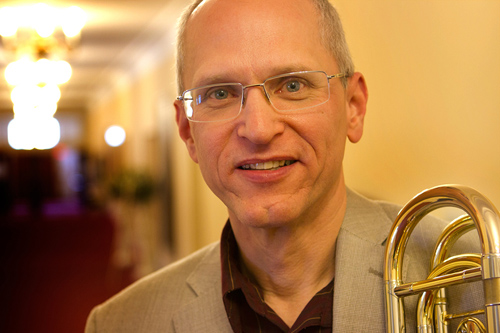 The process was fascinating to me, and it allowed me to talk at length about Symphony Hall, a place I have known and loved deeply for nearly three decades. I have been in every office in the building, explored every area in the basement, and spent untold hours
in rehearsal and concert. I have also spent a great deal of time just sitting in the hall and listening - looking at the copies of Greek and Roman statues of real and mythological characters related to the arts that grace niches above the second balcony. In
those times of quiet contemplation, I think about the great conductors and soloists that have been on stage, and about my colleagues - current colleagues and those now gone from both the BSO and life itself - and how inspiring they have been to me.
The process was fascinating to me, and it allowed me to talk at length about Symphony Hall, a place I have known and loved deeply for nearly three decades. I have been in every office in the building, explored every area in the basement, and spent untold hours
in rehearsal and concert. I have also spent a great deal of time just sitting in the hall and listening - looking at the copies of Greek and Roman statues of real and mythological characters related to the arts that grace niches above the second balcony. In
those times of quiet contemplation, I think about the great conductors and soloists that have been on stage, and about my colleagues - current colleagues and those now gone from both the BSO and life itself - and how inspiring they have been to me.
I also remember vividly the 11 recording sessions I led at Symphony Hall with the New England Brass Band over the years. These were special times for me, bringing a group of fine amateur players into the Hall to experience being on stage there - something most of them had
never even dreamed of. I recall like it was yesterday our first recording session. The Band, truly overwhelmed with the moment, played a chorale as part of our warm up - our first sounds we made together in Symphony Hall. As the final chord rang out, nobody
moved. The only sound for a long minute of silence was of members weeping - they had never heard themselves in a room such as Symphony Hall, and they were awed by the moment. That I was able to bring that to the New England Brass Band - a truly fine group of
people - was a great joy.
So, tomorrow I will be saying goodbye to Symphony Hall - it will be my last concert on that storied stage. My next concerts with the BSO will be at our summer season at Tanglewood in July and August. When I take my "final bow" from the podium after tomorrow's concert,
I will be saying goodbye not only to the Symphony Hall audience, but to the Hall itself. To have played in the greatest concert hall in the world for these many years has been a joy beyond measure, and something I will never forget, its imprint on me now
being so very strong.
May 4, 2012 - COMMENTARY
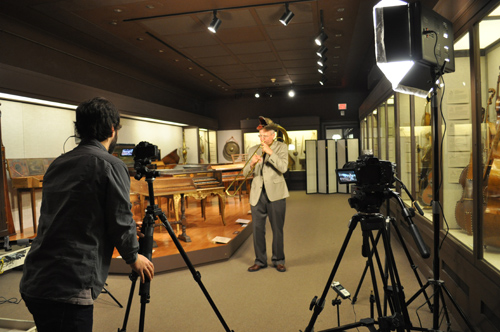 My "Final" events in Boston are coming fast and furious.
My "Final" events in Boston are coming fast and furious.
Tonight is another concert with the Boston Symphony Orchestra, another performance that includes Beethoven's Symphony 9 and another "Final bow" for me - and my other BSO colleague who is retiring this season, violist Mark Jeanneret. But before all of that happens later today, I found myself at the Museum of Fine Arts, Boston,
entering into a completely different world of music.
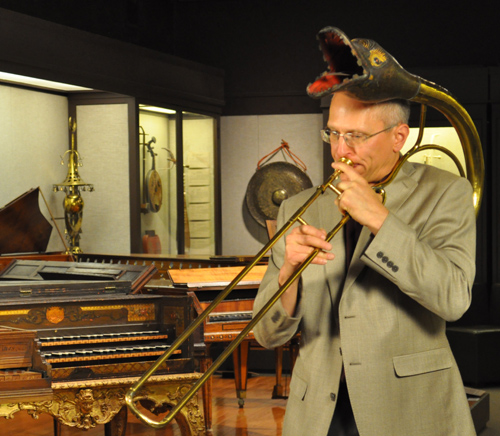 For many years I have had a happy association with the Museum of Fine Arts (MFA). My wife and I have been members of the museum, and I've been a volunteer in the Musical Instrument Gallery as well. Over the years I have given Gallery talks and demonstrations
of trombones, serpent and ophicleide. It has been a particular joy to play many of the MFA's instruments. Several years ago, I recorded my playing one of the MFA's serpents by Baudouin, as well as some spoken commentary, and that appears on the
Museum's audio guide.
For many years I have had a happy association with the Museum of Fine Arts (MFA). My wife and I have been members of the museum, and I've been a volunteer in the Musical Instrument Gallery as well. Over the years I have given Gallery talks and demonstrations
of trombones, serpent and ophicleide. It has been a particular joy to play many of the MFA's instruments. Several years ago, I recorded my playing one of the MFA's serpents by Baudouin, as well as some spoken commentary, and that appears on the
Museum's audio guide.
Darcy Kuronen, Curator of Musical Instruments at the MFA, asked me if I would be willing to come to the Museum to make a video recording of my playing three of the Collection's instruments - a serpent, ophicleide and buccin - for inclusion on a new
video project that the Museum is undertaking. They have plans to take their current book about the Collection and make it available in an electronic version that includes video of experts playing many of the instruments. With my days in Boston dwindling,
we were able to find time this morning for me to come to the gallery to play these magnificent instruments.
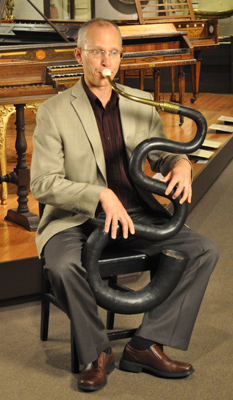 I had previously played on the MFA's Baudouin serpent and Guichard ophicleide, so playing them was rather familiar. The real treat of the day was playing the Museum's 19th century French buccin by Jean Baptiste Tabard. A buccin - for those who might not know what it
is - is a form of trombone with a bell shaped like a dragon (what we call "a zoomorphic bell"). These instruments were popular in France at the beginning of the 19th century, especially with military bands. The sight of a band with a row of buccins in the front -
colorfully painted and with their metal tongues wagging - must have been something to behold. The buccin has a very unstable overtone series - the way it plays is more unlike a trombone than like a trombone - due to the irrgularly shaped bell and purelly
conical nature of the bell section. And with the bell over the player's head instead of in front where it provides a visual reference for placement of the slide, playing the buccin poses particular challenges.
I had previously played on the MFA's Baudouin serpent and Guichard ophicleide, so playing them was rather familiar. The real treat of the day was playing the Museum's 19th century French buccin by Jean Baptiste Tabard. A buccin - for those who might not know what it
is - is a form of trombone with a bell shaped like a dragon (what we call "a zoomorphic bell"). These instruments were popular in France at the beginning of the 19th century, especially with military bands. The sight of a band with a row of buccins in the front -
colorfully painted and with their metal tongues wagging - must have been something to behold. The buccin has a very unstable overtone series - the way it plays is more unlike a trombone than like a trombone - due to the irrgularly shaped bell and purelly
conical nature of the bell section. And with the bell over the player's head instead of in front where it provides a visual reference for placement of the slide, playing the buccin poses particular challenges.
But I like challenges! And recording on these instruments was a great experience for me. The camera crew used three cameras, and I look forward to seeing the finished product. Most of all, this morning got me back in the MFA one more time, reliving
a musical past when all of the instruments were not hung up on walls or behind glass, but were in the hands of musicians on a daily basis. I have been particularly fortunate to have the opportunity to have such a great relationship with the Museum of Fine Arts,
Boston, and will look back at today as a highlight of my long collaboration with instruments there. Serpent, ophicleide and buccin - three instruments that were part of the long history of musical instrument development of which I am still a part today.
The recording was made in the MFA's musical instrument gallery. As soon as the recording session was over, the gallery opened and a flood of students ran in, eyes wide, looking at the instruments. Some had audio guide headphones on and two were standing in front of the serpent,
perhaps at that very moment listening to me play an etude by Jean Bapiste Metoyen on the serpent. I had to smile - here two more people were hearing the sound of the serpent for perhaps the first time. This is the world we live in - all of us have left marks
wherever we have been, and we rarely know the impact we are making on someone at any given moment. Something to think about, for sure!
May 3, 2012 - COMMENTARY
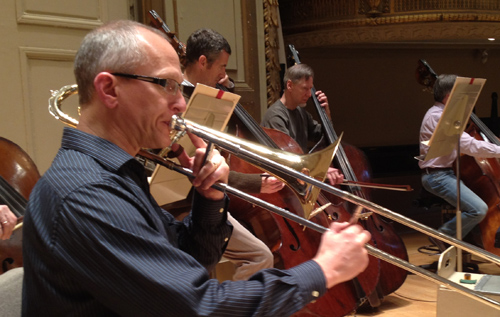 Today began my farewell to the Boston Symphony, with my final rehearsal in Symphony Hall and the first of my final three concerts there as well.
Today began my farewell to the Boston Symphony, with my final rehearsal in Symphony Hall and the first of my final three concerts there as well.
When I announced my retirement from the Boston Symphony last August - and, later, my subsequent appointment as Professor of Trombone at Arizona State University - the actual date that I would be leaving Boston seemed very far away. But it is now upon me.
Our schedule of packing and moving is a bit complex, but for now, it's enough to know that on Satuday night, I will have played my last concert in Symphony Hall. We will be moving to Arizona later this month before returning to Massachusetts for several weeks
of the Boston Symphony summer festival at Tanglewood. My final concert with the BSO will be on August 5 followed by the annual Boston Symphony retiree party, and we will finally be in Arizona for good on August 7.
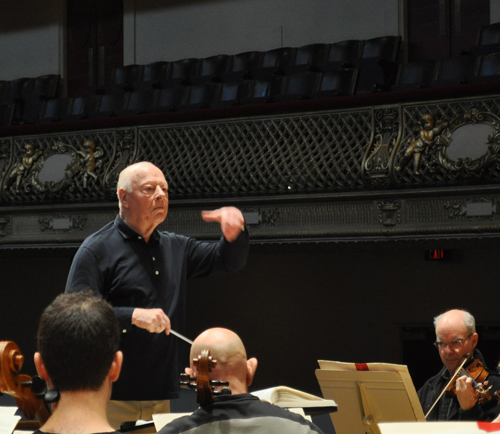 Yesterday I had my last rehearsal in Symphony Hall and the program for this special week is Stravinsky's Symphony of Psalms and the iconic Symphony 9 of Beethoven. I have played both of these pieces many times, but this time, it all feels
different. At rehearsal today, I was taking in many memories of my time in Symphony Hall - a place I have dearly loved for nearly 30 years. I have spent more time in that building than any other in the world apart from my home - and at times, it feels I am
spending MORE time there than at home. Concerts, rehearsals, recording sessions, television show tapings - I've been part of all of that in Boston's proud temple of music.
Yesterday I had my last rehearsal in Symphony Hall and the program for this special week is Stravinsky's Symphony of Psalms and the iconic Symphony 9 of Beethoven. I have played both of these pieces many times, but this time, it all feels
different. At rehearsal today, I was taking in many memories of my time in Symphony Hall - a place I have dearly loved for nearly 30 years. I have spent more time in that building than any other in the world apart from my home - and at times, it feels I am
spending MORE time there than at home. Concerts, rehearsals, recording sessions, television show tapings - I've been part of all of that in Boston's proud temple of music.
This week is made all the more special by the presence of Bernard Haitink on the podium (photo above, right). Maestro Haitink is one of the great conductors of the 20th and 21st centuries - a man who brings a unique blend of superb musical sense and gravitas
to everything he conducts. He has been coming to the BSO regularly since 1985 - the year I joined the orchestra - and for many years he was the BSO's principal guest conductor. We have shared many wonderful concerts together - in Symphony Hall, in Carnegie Hall and
on tour in Europe. We have made several recordings with him as well, and in particular his interpretations of the Brahms Symphonies (released on Philips) stand out as particularly memorable.
In addition, I have enjoyed many conversations with Maestro Haitink - they have been far reaching, from the Symphonies of Gustav Mahler to historical instruments like the serpent and ophicleide. Two weeks ago, I played ophicleide with the BSO in performances of
Mendelssohn's A Midsummer Night's Dream with Maestro Haitink on the podium. This was a very happy collaboration all around, and it was such a pleasure to play the ophicleide again with my colleagues in Symphony Hall, something I have now done on many
occasions.
The Symphony 9 of Beethoven is one of the crowning achievements of western music and the bass trombone has a prominent solo passage along with the celli and bassi of the orchestra and basses of the chorus. My colleague, Toby Oft, snapped a photo
(above, left) of me playing the recitative that is well known to every bass trombone player.
At the end of the concert, I was called to the front of the stage for my "final bow" in Symphony Hall. As I stood on the podium acknowledging the support of the audience, I looked around and enjoyed a rare moment. I had a dream and I got to live it, by God's
grace. There is much more to come in the next few days, but today's rehearsal and concert were the beginning of a farewell to Boston that will lead us in a few weeks to saying "hello" to Arizona in a new way.
Seid umschlungen, Millionen! Diesen Kuss der ganzen Welt!
May 1, 2012 - COMMENTARY


 Here is a happy progression, and something for which we are very grateful.
Here is a happy progression, and something for which we are very grateful.
Our home in the Boston area has been a place of many memories; I spoke of this in the entry of March 4, 2012, below. Moving to Arizona means leaving behind everything that we have that is tangible in Massachuetts - home and belongings. Our belongings will travel
to Arizona in a moving van, but we needed to sell our home.
When we put it on the market in March, we did not know what to expect. The economy is not especially robust, and the housing market in particular has been hit hard. But we knew that in time, God would lead the process of selling our home to fruition in the
way that was best for us.
And that has happened. That our home went under contract after being on the market for only four days is a stunning thing. All of the angles required to fall into place - the buyers' mortgage approval, house inspection and appraisal, etc. - have all moved forward
smoothly. And so it is that at the end of this month, we will turn the keys over to a new owner who will call our house their home.
As a result, we are in the midst of a jumble of boxes, with bubble pack and packing tape in the air. Soon the house will be empty as one in Arizona fills up. Every day there is packing to be done, yet one step in moving into a new chapter of life.
April 7, 2012 - COMMENTARY
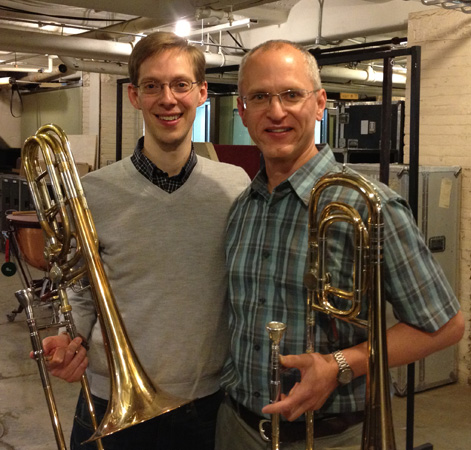 The memo on the bulletin board in the basement of Boston's Symphony Hall is dated April 3, 2012, and begins with a straight-forward sentence:
The memo on the bulletin board in the basement of Boston's Symphony Hall is dated April 3, 2012, and begins with a straight-forward sentence:
We are delighted to confirm that James Markey, currently bass trombonist of the New York Philharmonic, has accepted the position of bass trombonist of the BSO, effective August 6, 2012.
And with those words, the Boston Symphony Orchestra announced the impending arrival of its new bass trombonist, who will succeed me in the chair I have held for 27 years.
I cannot really express how happy I am that the audition process for my successor led to such a great conclusion. Jim Markey is a tremendous player and person, and his accomplishments as a member of the New York Philharmonic and Pittsburgh Symphony are
well known to anyone who follows the goings on of orchestral trombonists. Jim's solo albums, Off Road and On Base are superb examples of the highest level of trombone playing. His rendition of the e minor Cello Sonata
by Johannes Brahms represents some of the finest bass trombone playing I have ever heard.
Auditions do not always result in a winner. Sometimes, an audition committee simply does not hear the person they would like to hire, and in those situations, nobody is unhappier than the audition committee itself, which needs then to repeat the whole
audition process over again. When that happens, it delays the ability of a section of begin to build something new. I announced my retirement from the Boston Symphony effective August 5 of this year on August 17 of LAST year - nearly a year before I would be leaving - in order to give the BSO the opportunity to schedule
an audition during this season which hopefully would result in the hiring of a new player. Our hope was that a new player could then begin as soon as I left Boston and headed to Arizona State University. With the hiring of Jim Markey, that plan has come to fruition:
I will play my final concert with the BSO on Sunday, August 5 (my last chord will be in C major, the final chord of Berlioz's Symphonie fantastique) and Jim will play his first rehearsal several days later, on Tuesday, August 9. At the end of my final
concert, I will be brought up to the podium in the Koussevitzky Music Shed at Tanglewood to take my "final bow" before my colleagues and the audience assembled, knowing that Jim is in the audience, ready in a few days to take his first bow as a member of the BSO.
Jim and I have known each other for many years. In fact, we graduated from neighboring high schools - I from Jefferson Township High School in Oak Ridge, New Jersey, and he from Hopatcong High School in Hopatcong, New Jersey - 20 years apart. In our conversations
over the last few days (Jim was in Boston to sign his contract and begin laying the groundwork to move with his family to Boston soon - the photo above was taken in the basement of Symphony Hall a few days ago), we recalled that his family had attended West Side United Methodist Church in Hopatcong, a church my
father had pastored for several years. And we had to laugh when he told me that when he was 10 years old, the pastor of West Side had given Jim - then a very young, aspiring trombonist - an article from the local paper that told of my winning the Boston Symphony
bass trombone position. The connnections are remarkable.
I wish Jim and his family the very best as they transition from New York to Boston. I pray he will have a career in the BSO that is as wonderful as I have had, and I know he will bring superb artistry to our fine section, raising the bar for everyone and setting new standards for orchestral performance.
The metaphor is apt, "He shall increase, I shall decrease." My time in the BSO is nearing its conclusion as my wife and I prepare to move on to new adventures in Arizona. Knowing that Jim will be joining Toby Oft, Steve Lange and Mike Roylance in the Boston
Symphony low brass section pleases me greatly, and I know you join me in looking forward to seeing this section inspire us with their playing. Bravo, Jim!
March 31, 2012 - COMMENTARY
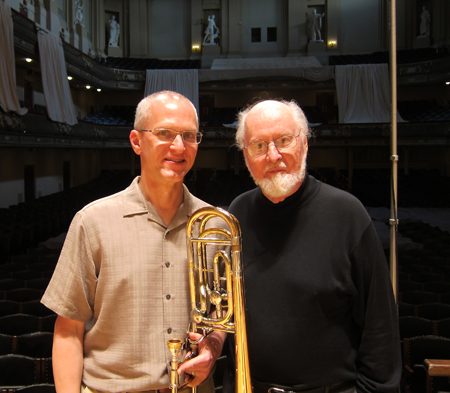
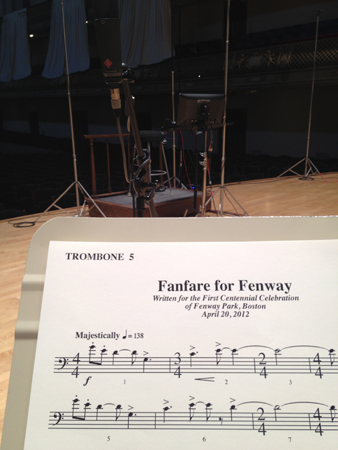 One of the great joys of my career as a member of the Boston Symphony has been the opportunity to work with composer/conductor John Williams. John needs no introduction - his name is synonymous with the genre we call film music, with his
soundtracks to Star Wars, ET, Jaws, Raiders of the Lost Ark and a host of other films being well known to millions of people. John was conductor of the Boston Pops Orchestra when I joined the Boston Symphony and we have enjoyed a very nice friendship over
the years. In addition to making many CD recordings with him and the Boston Pops, I've been soloist with the Pops with John on the podium on two occasions - in performances of his Tuba Concerto (I was the first bass trombonist to play the piece on bass
trombone) and Simon Proctor's Serpent Concerto. In addition we have played concerts together that are too numerous to count, as well as recording the soundtracks to two of his movie scores, Schindler's List and Saving Private Ryan.
One of the great joys of my career as a member of the Boston Symphony has been the opportunity to work with composer/conductor John Williams. John needs no introduction - his name is synonymous with the genre we call film music, with his
soundtracks to Star Wars, ET, Jaws, Raiders of the Lost Ark and a host of other films being well known to millions of people. John was conductor of the Boston Pops Orchestra when I joined the Boston Symphony and we have enjoyed a very nice friendship over
the years. In addition to making many CD recordings with him and the Boston Pops, I've been soloist with the Pops with John on the podium on two occasions - in performances of his Tuba Concerto (I was the first bass trombonist to play the piece on bass
trombone) and Simon Proctor's Serpent Concerto. In addition we have played concerts together that are too numerous to count, as well as recording the soundtracks to two of his movie scores, Schindler's List and Saving Private Ryan.
Last week my wife and I were on vacation in Arizona, continuing our preparations to move there in a few weeks. As is sometimes the case, a last minute recording session with members of the Boston Pops materialized and while my participation was not mandatory (since I was
officially on vacation from the Boston Symphony), I could not miss the opportunity to record a new fanfare by John Williams. So I took a "red eye" flight overnight from Phoenix to Boston, played the recording session in Symphony Hall, and turned around and flew
back to Arizona - all in 24 hours.
But it was worth it. 2012 is the 100th anniversary of the opening of Fenway Park in Boston, home of the Boston Red Sox. John Williams had been asked to compose a fanfare to celebrate the occasion and he composed it for members of the Boston Pops Orchestra
brass and percussion section. I've recorded several of John's other fanfares over the years, his Liberty Fanfare and several of his Olympics fanfares including, The Olympic Spirit and Summon the Heroes. This new
fanfare was composed for six trumpets, six horns, five trombones, two tubas, percussion and timpani. The recording session was held at Symphony Hall in Boston.
It is such a thrill to be a part of a recording session such as this. No concerts or rehearsals preceeded it - we just sat down and started playing for the microphones. The Fanfare for Fenway has that John Williams "signature sound" and in a few hours,
we had recorded the full fanfare, a 30 second version and a short "loop" of the piece that can be used on television. The trombone section consisted of BSO players Toby Oft and Steve Lange, and Karna Millen (US Coast Guard Academy Band) and Adam Rainey (bass
trombone student at New England Conservatory of Music).
The photos accompanying this entry tell a little of the story - John Williams and me together during a break in the recording session, and my view of the podium through recording equipment. Perhaps you'll hear the Fanfare for Fenway sometime during
the 2012 Major League baseball season. I know that when I hear it, I'll be smiling, remembering a nice moment in time.
March 14, 2012 - COMMENTARY
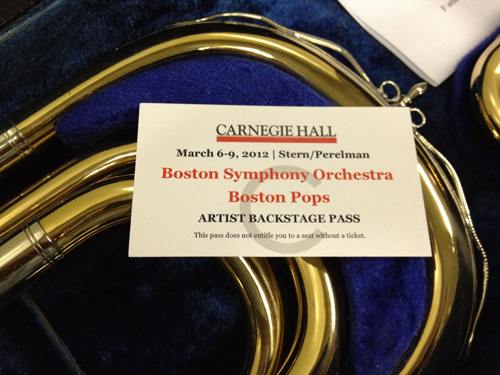 Last week the Boston Symphony Orchestra travelled to Carnegie Hall in New York City for four concerts. It was my final tour as a member of the BSO and the trip was full of memorable events and memories.
Last week the Boston Symphony Orchestra travelled to Carnegie Hall in New York City for four concerts. It was my final tour as a member of the BSO and the trip was full of memorable events and memories.
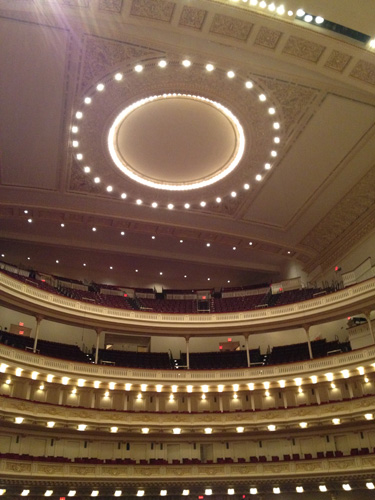 I grew up in and around New York City - first in Queens, then in Valley Stream on Long Island, and then in northern New Jersey. After graduating from Wheaton College in Illinois with my Bachelor's degree,
my wife and I returned to New York City where we lived for three years while she finished college at Columbia University and I went to graduate school at New York University. New York City is in my blood - in
many ways it shaped, formed and changed me.
I grew up in and around New York City - first in Queens, then in Valley Stream on Long Island, and then in northern New Jersey. After graduating from Wheaton College in Illinois with my Bachelor's degree,
my wife and I returned to New York City where we lived for three years while she finished college at Columbia University and I went to graduate school at New York University. New York City is in my blood - in
many ways it shaped, formed and changed me.
As a young boy, I remember many trips into the city, often to hear concerts at what was then called Philharmonic Hall - the home of the New York Philharmonic now called Avery Fisher Hall. My family saw many
movies and shows at Radio City Music Hall, and as I got older, my trips to New York City became more frequent as I visited museums and enjoyed all of the tourist spots that even locals enjoy - the Statue of Liberty,
Empire State Building, World Trade Center (I don't think I will ever get used to seeing the New York skyline without those iconic towers...), Rockefeller Center and so much more. In recent years I've enjoyed doing
research on musical instruments at the Metropolitan Museum of Art as well.
But it is music that is my primary connection to New York City. I cannot begin to count the number of concerts I've attended, sitting in the audience at Avery Fisher Hall or Carnegie Hall. In the mid 1970s when
my wife and I were in college, we attended countless concerts, including many by the Chicago Symphony Orchestra. My teacher, Edward Kleinhammer, was a member of the CSO from 1940-1985, and the CSO came to
Carnegie Hall three times a year. My wife and I had a subscription to those concerts and we saw every one of them. Memorable.
And I recall a week that truly shaped me, where I heard the St. Saens "Organ Symphony" performed by three orchestras in just a few days - the Orchestre de Paris, a university orchestra and the New York Philharmonic
(conducted by Leonard Bernstein). Hearing three very different performances of the same work in such a compact period of time resulted in an important epiphany for me, as I realized that my own creative voice
should not be simply modeled after others, but that I could find my own, distinctive expression. It may seem like an obvious, self-evident concept, but having only recently left Chicago with its great tradition
of brass playing, it was an important moment for me to realize that there were many different ways to do and make music. I don't think I could have had that unique experience in any city in the world except
New York.
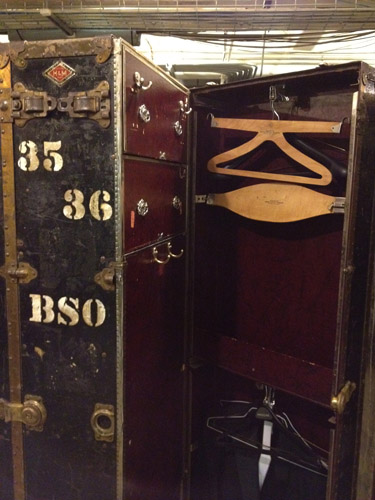 And, so, this trip to New York brought back a lot of wonderful memories for me. Doing a quick calculation, I think I have played about 100 concerts in Carnegie Hall, and I've been in the audience for uncounted
others. Carnegie Hall is a place steeped in history, and I have always felt a thrill every time I have walked on the stage, from the first concert I played there with the American Symphony in 1978 to my final concert
there with the Baltimore Symphony in 1985, to these recent concerts. The view from the stage is breathtaking (photo above, right), and I have never tired of it.
And, so, this trip to New York brought back a lot of wonderful memories for me. Doing a quick calculation, I think I have played about 100 concerts in Carnegie Hall, and I've been in the audience for uncounted
others. Carnegie Hall is a place steeped in history, and I have always felt a thrill every time I have walked on the stage, from the first concert I played there with the American Symphony in 1978 to my final concert
there with the Baltimore Symphony in 1985, to these recent concerts. The view from the stage is breathtaking (photo above, right), and I have never tired of it.
Carnegie Hall also brings back many special memories of the years when my youngest daughter, Robin, worked there. During that time, it was so nice to spend time with her, and also to enjoy watching her
work in such an iconic institution - to say I was and am proud of her doesn't begin to express my feelings. The artist passes we receive on each trip (photo above, left) used to be printed by Robin, and whenever I hold one in my hand, I think of her. Robin has moved on to San Francisco
where she is Communications Manager for San Francisco Opera, but her time at Carnegie Hall will always be memorable for us and this visit brought that all back in a wonderful way once again.
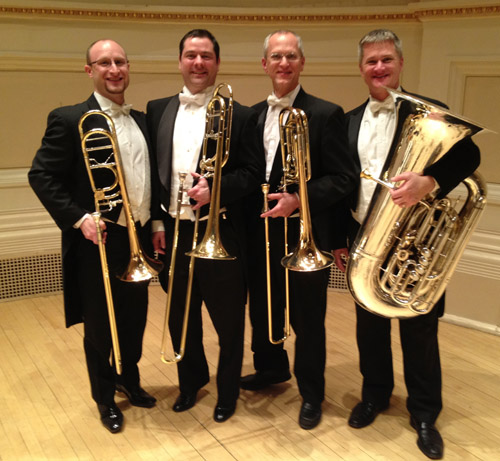 On this tour, we played four concerts in Carnegie Hall - three with the BSO and one with the Boston Pops Orchestra. The contrast of repertoire - Beethoven's Missa solemnis, Berlioz's Symphonie
fantastique and Shostakovich's Symphony 5 reflected against the Pops concert with music by my good friend Chris Brubeck and Benny Goodman - was striking, but audiences for the two types of concerts were very different and knew what they were getting.
On this tour, we played four concerts in Carnegie Hall - three with the BSO and one with the Boston Pops Orchestra. The contrast of repertoire - Beethoven's Missa solemnis, Berlioz's Symphonie
fantastique and Shostakovich's Symphony 5 reflected against the Pops concert with music by my good friend Chris Brubeck and Benny Goodman - was striking, but audiences for the two types of concerts were very different and knew what they were getting.
The trip also brought visits with former students, friends and colleagues, meals at my favorite restaurants, and time just walking the streets, taking in the sights and sounds in a very nice time of remembering.
This tour also brought to mind the many other tours I've been on with the Boston Symphony - tours to Europe, Asia, North and South America and even Africa. On all of those tours, my concert formal wear travelled
in BSO tour trunk number 36 Upper (photo at left). These tours have allowed me to see the world - Tokyo, London, Edinburgh, Berlin, Madrid, Salzburg, Paris, Milan, Athens, Hong Kong, Vienna, the Canary Islands, Buenos Aires and many, many
more cities too numerous to count. My three passports are full of artist visas and stamps from airports, full of extra pages because the tours were so numerous. How many tours? I haven't been able to count - perhaps
15 or so. Never did I ever dream I would have the opportunity to see the world, but it happened, and all because I had a trombone in my hand.
The BSO tour trunks have a lot of miles on them, and when we returned home to Boston and I emptied my trunk, a page in my life had turned.
Yet this is all good. All good.
After our last concert at Carnegie Hall, we snapped a photo of our section (right) - Toby Oft, Steve Lange, myself and Mike Roylance. We are enjoying a nice moment in time right now, as we are playing great concerts
together, aware that a special moment in time is coming to a close while a new one is around the corner. But we are not looking past today - every day brings new music, new challenges, new collaborations, and the great
thing about my section is that we are all-in every minute, whether it is a chamber music concert, a Youth Concert, a Pops concert or a concert with the BSO playing the great symphonic music of all time.
Carnegie Hall. What a place. And what a great opportunity I've had to play so many concerts there and in Symphony Hall, Boston, two of the greatest concert halls in the world.
March 14, 2012 - COMMENTARY
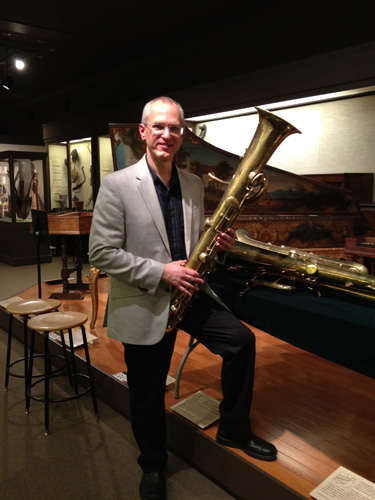 The last few days have been moving at the speed of light so I'm just getting caught up on an unexpected day off. Symphony Hall has no power today - a fire at an electrical transformer in
Boston's Back Bay area has left the Symphony Hall neighborhood in the dark. Today's BSO Youth Concerts have been cancelled, so I have a day off that I had not planned for. While I will
miss the concerts, I'm grateful for a day to catch my breath.
The last few days have been moving at the speed of light so I'm just getting caught up on an unexpected day off. Symphony Hall has no power today - a fire at an electrical transformer in
Boston's Back Bay area has left the Symphony Hall neighborhood in the dark. Today's BSO Youth Concerts have been cancelled, so I have a day off that I had not planned for. While I will
miss the concerts, I'm grateful for a day to catch my breath.
On March 5, I travelled to the Museum of Fine Arts Boston, where I have given many demonstrations of musical instruments. Over the years, I've given demonstrations and talks about
trombones and serpents - my playing of one of the MFA's Baudouin serpents appears on the Museum's audio guide. On this day, I gave a talk about the ophicleide - the French brass instrument
that was the next step after the serpent on the long evolutionary path to today's tuba.
I always enjoy giving talks and demonstrations at museums. I feel very fortunate that my work with early brass instruments has led to my having a nice relationship with many museums around
the world, many of which have been generous in allowing me access to examine and, in many cases, play their instruments. My relationship with the MFA dates back many years, and not only are
my wife and I members of the Museum, I am a volunteer as well.
The Musical Instrument Gallery was packed to capacity for my talk, and I gave those assembled an historical overview of the ophicleide, from its invention in 1817 and its use by composers
as diverse as Berlioz and Wagner. I brought along my own ophicleide in C (Roehn, Paris, c1855) - shown at left - to play a number of pieces including Sir Arthur Sullivan's, "The Lost Chord," and the "Amen fugue"
from Berlioz's "Damnation of Faust." The MFA has three ophicleides in its collection - a 9-key bass ophicleide in B flat by Guichard (1840), a 9-key bass opihcleide in C by Halary
(the inventor of the ophicleide, c1820-25) and 9-key alto ophicleide in E flat by Devaster (c1840). The Museum's Guichard ophicleide is in playable condition, so I was able to demonstrate
that instrument so the audience could hear the difference in timbre between a C and B flat ophicleide.
My visit to the MFA coincides with the publication next week of an article I have written for the Boston Symphony Orchestra program book about the Orchestra's collection of historical instruments. The
article will run for several weeks, and I was pleased to have the opportunity to introduce BSO audiences to the Orchestra's fine collection of ancient instruments in this way. Also, later this spring,
my article, "Serpents in Boston: The Museum of Fine Arts and Boston Symphony Orchestra Collections" will appear in the Galpin Society Journal, the leading peer-reviewed journal devoted to the
study of musical instruments.
I look forward to returning to the MFA later this spring to record on their Guichard ophicleide, Baudouin serpent and their buccin (a form of trombone with zoomorphic bell) for a planned
e-book version of their book on the Musical Instrument collection. Old sounds made new...
March 4, 2012 - COMMENTARY
 Today our home in the Boston area went on the market for sale. The photo at right tells the simple story - we're moving soon.
Today our home in the Boston area went on the market for sale. The photo at right tells the simple story - we're moving soon.
We've lived in our home for 27 years. You don't get a lot of 27 year periods in a lifetime - this is the longest we have ever lived in one place. When I add it up, I've called
11 houses and apartments "home" since my parents brought me home from the hospital as a newborn to a little apartment in Pacific Grove, California. But our home here in the Boston area,
well, that has been home.
Here we watched our children grow up. It is from this driveway that I pulled out every day to go to work at Symphony Hall. We have watched the trees change color every fall, shoveled
snow every winter, mowed the grass. A swing set was in the back yard for many years - dozens of cords of wood have warmed us in our wood stove. There are uncounted memories in
this place we have called "home" and today it has gone up for sale, for another person or family to buy. And they will call it, "home" as well.
Already, we are increasingly having one foot in Arizona as we begin the transition from Boston to the west. I've been doing a lot of work for Arizona State University in recent weeks, and at this time
of year, my focus is on the admission process for new students for the fall. In just a few days, the Boston Symphony Orchestra will have an audition for my successor, and that will be
another tangible sign of the transition that is now taking place. We are taking trips each month to Arizona where we are working on our new home there, and the transition
from east to west is rapidly unfolding. The sale of our house in the Boston area is a huge event, and one of many huge events in this remarkable season of life.
It's all part of the great cycle of life. It's exciting to see all of this unfold, and the sign that went up on our lawn today was a big step.
February 2, 2012 - COMMENTARY
 Here we go again...
Here we go again...
The New England Patriots football team will be meeting the New York Giants again in the Superbowl this weekend. This is a rematch of the Superbowl four years ago when the Patriots
had not lost a game all season but lost a close game to the Giants in the Superbowl. The hype for this game is tremendous, and given the way both teams played through the regular
season, very few people imagined they would be in the "big game." Yet here they are, two flawed but immensely talented teams. It will be an exciting game to watch, full of
metaphors, legacy-building, and bragging rights. One city will be celebrating on Sunday evening; the other will be dealing with a string of "what ifs."
But no matter the outcome, it is exciting to see the Patriots in their fifth Superbowl in 10 years. That is a remarkable run of success. As I prepare to leave Boston later this year,
I will always look back at Boston's sports life and be grateful that I lived there during "the good old days." Patriots, Red Sox, Celtics, Bruins - they've all won championships in the
last 10 years. That is a run unequalled by any other city. It's been fun but of course it won't last forever. But here's hoping it will last at least for one more game! UPDATE,
February 5: Well, it didn't last for one more game. The Giants won the Super Bowl in an exciting game that came down to the last play. Neither team played particularly well,
but the Giants played well enough to win. The Patriots live for another day, with a lot of questions to answer in the off-season. But it was a good season, and there is no shame
in losing in the Super Bowl - 30 other teams would have loved to have been in that position. While we will always have a cheering interest in our Boston teams, we are turning our
interest to the Arizona teams - the Cardinals, Diamondbacks, Suns and Coyotes. With all of those teams being in the western conferences and opposite the Boston teams, we can
happily cheer for both our Arizona and Boston teams with no conflict of loyalty. And when they play each other, I'll wear, for instance, a Cardinals shirt and a Patriots hat.
It is, after all, only a game!
January 7, 2012 - NEW
A new year is upon us, and it is one that will be filled with major changes for my wife and me. We are already in the process of packing for our move to Arizona this summer; our house will be put on the market to sell in a few weeks so
it is a busy time but exciting as well.
Today, as part of the weekly Boston Symphony Orchestra radio broadcast, the intermission feature will be an interview of me with Brian Bell, the BSO radio broadcast producer. I've done many radio interviews in my life, but this one
took some nice directions in the questioning and allowed me to talk about many facets of my musical life in new ways. As part of the interview, Brian interviewed John Williams who spoke generously about our friendship. I've put this interview
(19 minutes long) on my website and you can listen to it by clicking
HERE.